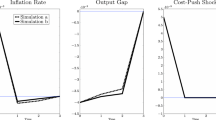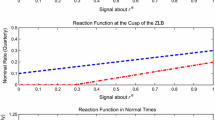Abstract
In the aftermath of the recent global financial crisis, monetary authorities, while pursuing traditional objectives, such as the control of inflation, are also eager to promote financial stability. In this paper, we model the strategic interaction of the central bank and the financial sector and explore a simple monetary policy game with perceived substantial risks to financial stability, where the central bank can be of two types, one pursuing strict inflation-targeting and the other concerned with affecting the expectations formed by the financial sector participants; however, the financial sector is unsure which, due to incomplete information. The conclusion is that for small shocks to inflation there is a pooling equilibrium, whereas for larger shocks there is separation. In the latter case, the central bank that has an explicit financial stability concern is willing to exercise more muted control to inflation in order to reinforce the safety of the financial sector.


Similar content being viewed by others
Notes
See e.g. Goodhart et al. (2005, 2006) for an early account of models of financial fragility and its effect on monetary policy and Kasselaki and Tagalakis (2014) for an evaluation of the degree of financial fragility and policymakers’ risks to financial stability calling for proactive action and cooperation between all relevant authorities.
See Kokores (1999), pp. 223–241, for an account of modeling a flexible inflation targeting central bank with a dual mandate of price and financial stability.
We address policy termed as ‘leaning-against-the-wind’ (henceforth LATW) monetary policy, while research antecedent to the crisis favored the term ‘pre-emptive’ monetary policy to define policy with greater direct account of asset-price misalignments, when they pose significant risks to macroeconomic stability, namely before inflation forecasts are affected. This is the case for an accumulation of financial imbalances (encompassing also increasing debt and capital stock overhangs—i.e. disequilibrium excess stock) that may be masked by a regime of low and stable inflation (for early accounts see e.g. Goodhart 1995; Kent and Lowe 1997; Cecchetti et al. 2000; Shiratsuka 2001; Borio and Lowe 2002; for a review see Kokores 2015).
For an account of the use of ‘strict inflation targeting’ in terms of an operational monetary policy design see e.g. Svensson (1999).
See e.g. Papademos (2006) for an account of ECB’s monetary policy strategy mix of rules and constrained discretion so as to promote economic stability.
By taking expectations in Eq. (1) we obtain,
$$\begin{aligned} Ex=0, \end{aligned}$$(4)where E is the expectations operator. This result shows that on average monetary policy is just neutral.
To specify how the short-term rate of interest, i, determines monetary stance, assume:
$$\begin{aligned} x=F\left( r \right) \left( {0<{F}'<1} \right) . \end{aligned}$$(5)The restriction on \(F'\) means first, r and \(\pi \) are inversely related and second, in order to raise r and lower \(\pi \), it is necessary to raise i. It is supposed that the transmission mechanism from i to \(\pi \) is via r and its effect on the real economy. Substituting (3) in (5) and (5) in (1) shows that, given F, E\(\pi \) and \(\varepsilon \), the choice of i determines \(\pi \), r and x. Therefore, in determining strategy, B could as equally set a target for r, or for x, as choose the level of its instrument, i. From (4), the central bank’s monetary stance is on average neutral. Let \(F\left( {r^{{*}}} \right) =0\). If \(r>r^{*}\), monetary policy is restrictive and, if \(r<r^{*}\), it is expansionary. Then for simplicity we assume that x is as in (2).
For simplicity in notation, subscript 1 for time \(t=1\) is excluded throughout the paper.
Profits are perceived in terms of the margin between the rates charged on illiquid and relatively liquid financial assets (e.g. the former represented by loans to the real sector and the latter by interbank-market funds).
See e.g. Guégan and Tarrant (2012) for an evaluation of several proposed financial-sector risk measures as a way to enhance regulators’ efficiency.
Nevertheless, this requirement does not impose a restriction on out-of-equilibrium beliefs, namely beliefs about play at information sets with zero probability. It is contended, however, that advancing the definition of equilibrium would reduce the multiplicity of equilibria, yet at the expense of a considerable amount of technicality that will not contribute greatly to the main conclusions of the analysis.
We consider this limit to be well defined. Pay-offs of the stage-game are bounded (from the definitions of the objective functions), and, thus, the sequence of average pay-offs will converge as the time-horizon goes to infinity provided that the discounting factor is strictly less than one, \(\delta <\)1.
This result is similar to the main conclusion of Cukiernan and Liviatan (1991), where “imperfect credibility [of the ‘strong’ policymaker (similar to B of type 1)] turns out to be partially self-fulfilling in the sense that the strong policymaker does not deliver the target inflation it would have delivered under perfect credibility” (Cukiernan and Liviatan 1991, p. 101).
References
Andersen, T.M.: Credibility of policy announcements: the output and inflation costs of disinflationary policies. Eur Econ Rev 33(1), 13–30 (1989)
Backus, D.K., Driffill, J.: Inflation and reputation. Am Econ Rev 75(3), 530–538 (1985)
Ball, L.: Time consistent inflation policy and persistent changes in inflation. J Monetary Econ 36(2), 329–350 (1995)
Barro, R.J.: Reputation in a model of monetary policy with incomplete information. J Monetary Econ 23(1), 3–30 (1986)
Barro, R.J., Gordon, D.B.: A positive theory of monetary policy in a natural rate model. J Polit Econ 91(4), 589–610 (1983a)
Barro, R.J., Gordon, D.B.: Rules, discretion and reputation in a model of monetary policy. J Monetary Econ 12(1), 101–121 (1983b)
Barrett, C.R., Kokores, I., Sen, S.: Bubbles, instability and monetary policy games. In: Proceedings Public Choice Society Annual Meeting 2008, San Antonio TX (2008)
Borio, C.: Monetary Policy and Financial Stability: What Role in Prevention and Recovery? BIS Working Paper 440 (2014)
Borio, C.: The Financial Cycle and Macroeconomics: What have we Learnt? BIS Working Paper 395 (2012)
Borio, C., Lowe, P.: Asset Prices, Financial and Monetary Stability: Exploring the Nexus. BIS Working Papers 114 (2002)
Briault, C., Haldane, A., King, M.: Independence and accountability. In: Kurodo, I. (ed.) Towards More Effective Monetary Policy, pp. 299-326. London: Macmillan (1997)
Cecchetti, S.G., Genberg, H., Lipsky, J., Wadhwani, S.: Asset prices and central bank policy. In: Geneva Reports on the World Economy 2, International Centre for Monetary and Banking Studies and Centre for Economic Policy Research (2000)
Cukiernan, A., Liviatan, N.: Optimal accommodation by strong policymakers under incomplete information. J Monetary Econ 27(1), 99–127 (1991)
Cukierman, A., Meltzer, A.: A theory of ambiguity, credibility, and inflation under discretion and asymmetric information. Econometrica 54(5), 1099–1128 (1986)
Draghi, M.: Monetary policy communication in turbulent times. In: Speech at the Conference De Nederlandsche Bank 200 years: Central Banking in the Next Two Decades, April (2014). Available online: https://www.ecb.europa.eu/press/key/date/2014/html/sp140424.en.html
Drazen, A., Mason, P.R.: Credibility of policies versus credibility of policymakers. Q J Econ 109(3), 735–754 (1994)
Farooq-Akram, Q., Bårdsen, G., Lindquist, K.-G.: Pursuing financial stability under an inflation-targeting regime. Ann Finance 3, 131–153 (2007)
Goodhart, C.: Price stability and financial fragility. In: Sawamoto, K., Nakajima, Z., Taguchi, H. (eds.) Financial Stability in a Changing Environment, pp. 439-497. London: St. Martin’s Press (1995)
Goodhart, C., Sunirand, P., Tsomocos, D.P.: A risk-assessment model for banks. Ann Finance 1(1), 197–224 (2005)
Goodhart, C., Sunirand, P., Tsomocos, D.P.: A model to analyse financial fragility. Econ Theory 27(1), 107–142 (2006)
Guégan, D., Tarrant, W.: On the necessity of five risk measures. Ann Finance 8(4), 533–552 (2012)
Kasselaki, M.T., Tagalakis, A.O.: Financial soundness indicators and financial crisis episodes. Ann Finance 10, 623–669 (2014)
Kent, C., Lowe, P.: Asset-Price Bubbles and Monetary Policy. Economic Research Department, Reserve Bank of Australia, Research Discussion Paper 9709 (1997)
Kokores, I.: The Conduct of Monetary Policy under Risks to Financial Stability: A Game-Theoretic Approach. PhD Thesis, Department of Economics, University of Birmingham, UK (2009)
Kokores, I.: Lean-against-the-wind monetary policy, the post-crisis shift in the literature. SPOUDAI J Econ Bus 65(3–4), 66–99 (2015)
Nolan, C., Schaling, E.: Monetary Policy Uncertainty and Central Bank Accountability. London: Bank of England (1996)
Papademos, L.: Policymaking in EMU, strategies, rules and discretion. Econ Theory 27(1), 25–38 (2006)
Plosser, C.I.: Monetary rules: theory and practice. J Econ Dyn Control 49, 144–146 (2014)
Shirakawa, M.: Revisiting the philosophy behind central bank policy. In: Speech by the Governor of the Bank of Japan, at the Economic Club of New York, New York, April 22 (2010). Available online:http://www.bis.org/review/r100427b.pdf
Shiratsuka, S.: Asset Prices, Financial Stability, and Monetary Policy: Based on Japan’s Experience of the Asset Price Bubble. BIS Papers 1 (2001)
Svensson, L.E.O.: Inflation targeting as a monetary policy rule. J Monetary Econ 43, 607–654 (1999)
Svensson, L.E.O.: Inflation targeting: some extensions. Scand J Econ 101(3), 337–361 (1999a)
Tabellini, G.: Centralised Wage setting and monetary policy in a reputational equilibrium. J Money Credit Bank 20(1), 102–118 (1988)
Vickers, J.: Signalling in a model of monetary policy with incomplete information. Oxford Econ Pap 38(3), 443–455 (1986)
Woodford, M.: Interest and Prices: Foundations of a Theory of Monetary Policy. Princeton University Press, Princeton, NJ (2003)
Yellen, J. L.: Communications in monetary policy. In: Speech at the Society of American Business Editors and Writers 50th Anniversary Conference, Washington, DC, April (2013). Available online: http://www.federalreserve.gov/newsevents/speech/yellen20130404a.htm
Yellen, J. L.: Monetary policy and financial stability. Remarks by the Chair of the Board of Governors of the Federal Reserve System, 2014 Michel Camdessus Central Banking Lecture International Monetary Fund, Washington, DC, July 2 (2014). Available online: http://www.federalreserve.gov/newsevents/speech/yellen20140702a.htm
Author information
Authors and Affiliations
Corresponding author
Additional information
An earlier version was presented at the Public Choice Society conference, San Antonio, Texas, 10–13 March 2011. We have benefited greatly from constructive comments by John H. Wood, John Fender, Indrajit Ray, an anonymous referee of the Annals of Finance, and participants at the above conference. We are responsible for any remaining errors and omissions.
Rights and permissions
About this article
Cite this article
Barrett, C.R., Kokores, I. & Sen, S. Monetary policy games, financial instability and incomplete information. Ann Finance 12, 161–178 (2016). https://doi.org/10.1007/s10436-016-0276-6
Received:
Accepted:
Published:
Issue Date:
DOI: https://doi.org/10.1007/s10436-016-0276-6




